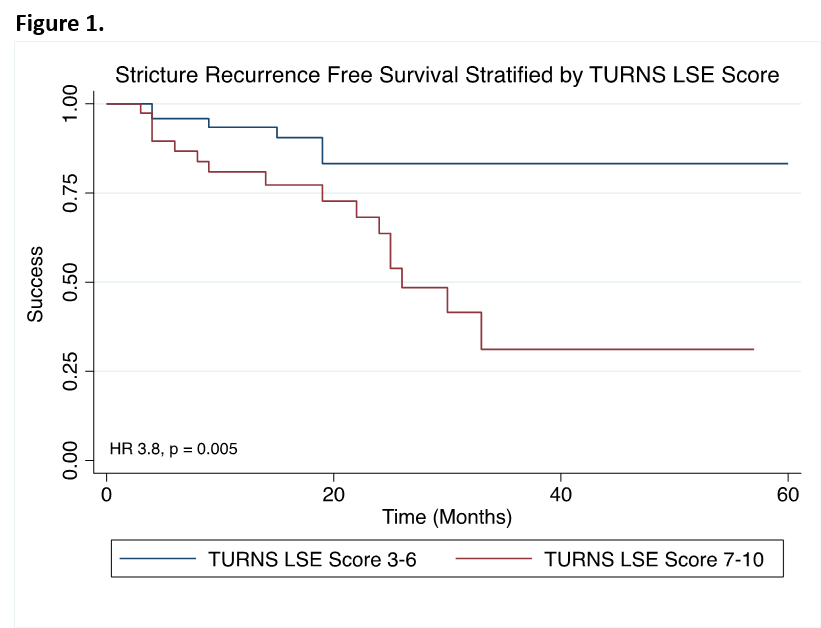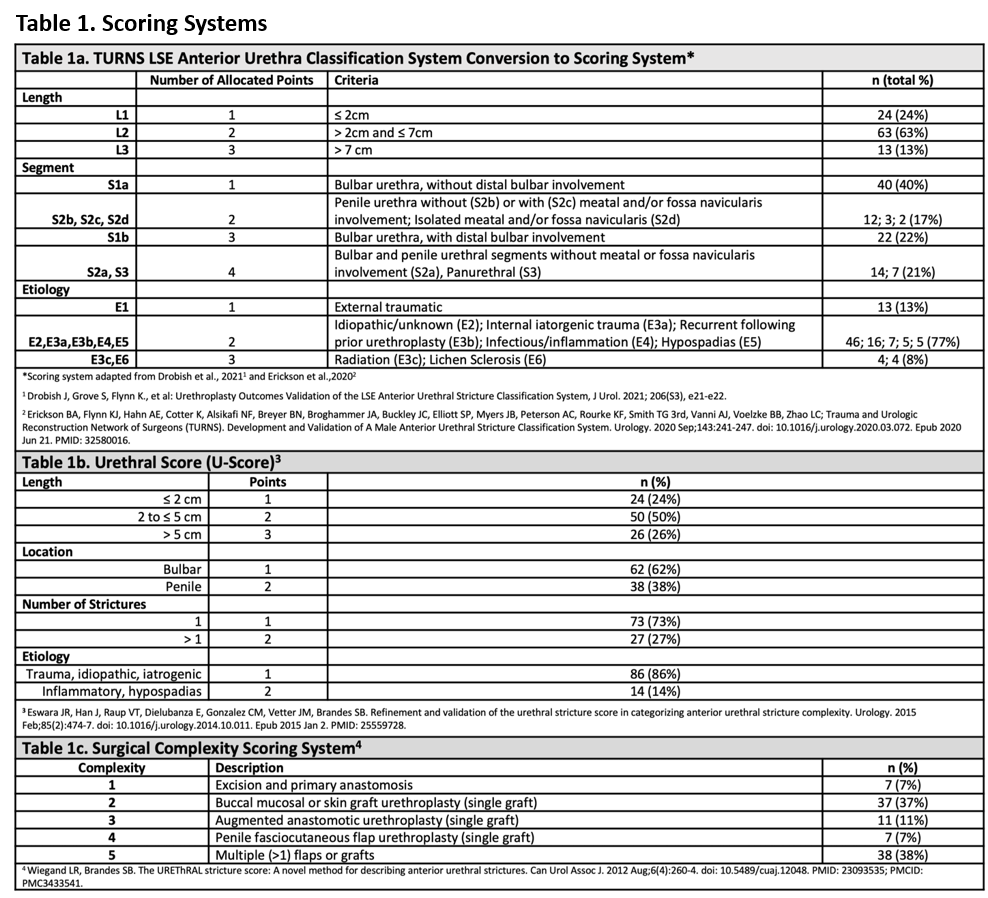Back
Poster, Podium & Video Sessions
Podium
PD31: Trauma/Reconstruction/Diversion: Urethral Reconstruction (including Stricture, Diverticulum) II
PD31-12: Evaluating Predictive Tools for Anterior Urethroplasty Outcomes: A Comparison of the TURNS LSE System and U-Score
Saturday, May 14, 2022
5:20 PM – 5:30 PM
Location: Room 252
Jane Kurtzman*, Rashed Kosber, Preston Kerr, Steven Brandes, New York, NY

Jane Kurtzman, MD
Columbia University Irving Medical Center
Podium Presenter(s)
Introduction: The choice of surgery for treating anterior urethral strictures depends on disease severity. The TURNS LSE Classification System and the U-Score (US) attempt to classify severity and predict clinical outcomes. We compared each system’s ability to predict surgical complexity (SC), intraoperative outcomes, and stricture recurrence.
Methods: We performed a retrospective chart review of male patients who underwent single-stage anterior urethroplasty from 2016-2020. A US and a TURNS LSE score (TLS) was calculated for each patient. Table 1 displays scoring systems, and point allocation for TLS - which we based on previously published predictive analyses. Pearson’s correlation and linear regression analyses were used to assess for collinearity between US and TLS, and for a relationship between US and TLS with SC, operating room time (ORT) and blood loss (EBL). Kaplan Meier curves and Cox Proportional hazard ratios were used to assess if US and TLS could predict stricture recurrence within 5 years of surgery.
Results: A total of 100 patients, mean age of 51 years (SD 17) and mean stricture length of 4.5 cm (SD 3.3), were included. Mean follow-up was 21 months (SD 15). 22% recurred within 5 years. We found a strong positive linear correlation between US and TLS (p < 0.001). Both US (r = 0.34, p = 0.0006) and TLS (r = 0.26, p = 0.009) positively correlated with SC. Increasing length and location for both US and TLS, linearly correlated with increasing complexity (all p < 0.05). TLS was positively correlated with ORT (r = 0.20, p = 0.048). Increasing TLS was significantly associated with an increased risk of stricture recurrence (HR 1.36, p = 0.017), but increasing US was not (p = 0.19). Patients with high TLS (7-10) were 3.8 times as likely to recur than patients with a low TLS (3-6), (HR 3.8, p = 0.005, Figure 1).
Conclusions: US and TLS can both predict SC, but only TLS can predict OR time and stricture recurrence. Conversion of the TURNS Classification System into a numeric score adds substantial functionality to this novel system.
Source of Funding: None


Methods: We performed a retrospective chart review of male patients who underwent single-stage anterior urethroplasty from 2016-2020. A US and a TURNS LSE score (TLS) was calculated for each patient. Table 1 displays scoring systems, and point allocation for TLS - which we based on previously published predictive analyses. Pearson’s correlation and linear regression analyses were used to assess for collinearity between US and TLS, and for a relationship between US and TLS with SC, operating room time (ORT) and blood loss (EBL). Kaplan Meier curves and Cox Proportional hazard ratios were used to assess if US and TLS could predict stricture recurrence within 5 years of surgery.
Results: A total of 100 patients, mean age of 51 years (SD 17) and mean stricture length of 4.5 cm (SD 3.3), were included. Mean follow-up was 21 months (SD 15). 22% recurred within 5 years. We found a strong positive linear correlation between US and TLS (p < 0.001). Both US (r = 0.34, p = 0.0006) and TLS (r = 0.26, p = 0.009) positively correlated with SC. Increasing length and location for both US and TLS, linearly correlated with increasing complexity (all p < 0.05). TLS was positively correlated with ORT (r = 0.20, p = 0.048). Increasing TLS was significantly associated with an increased risk of stricture recurrence (HR 1.36, p = 0.017), but increasing US was not (p = 0.19). Patients with high TLS (7-10) were 3.8 times as likely to recur than patients with a low TLS (3-6), (HR 3.8, p = 0.005, Figure 1).
Conclusions: US and TLS can both predict SC, but only TLS can predict OR time and stricture recurrence. Conversion of the TURNS Classification System into a numeric score adds substantial functionality to this novel system.
Source of Funding: None



.jpg)
.jpg)